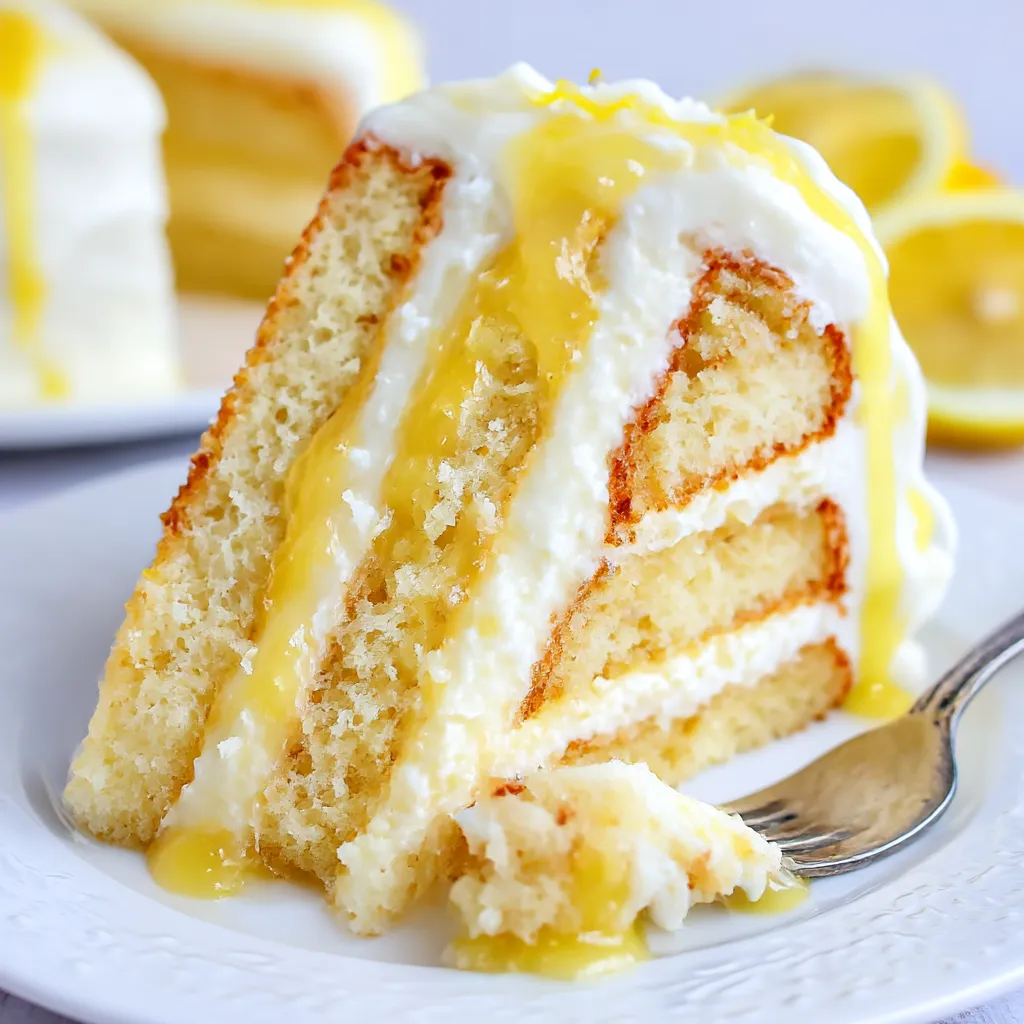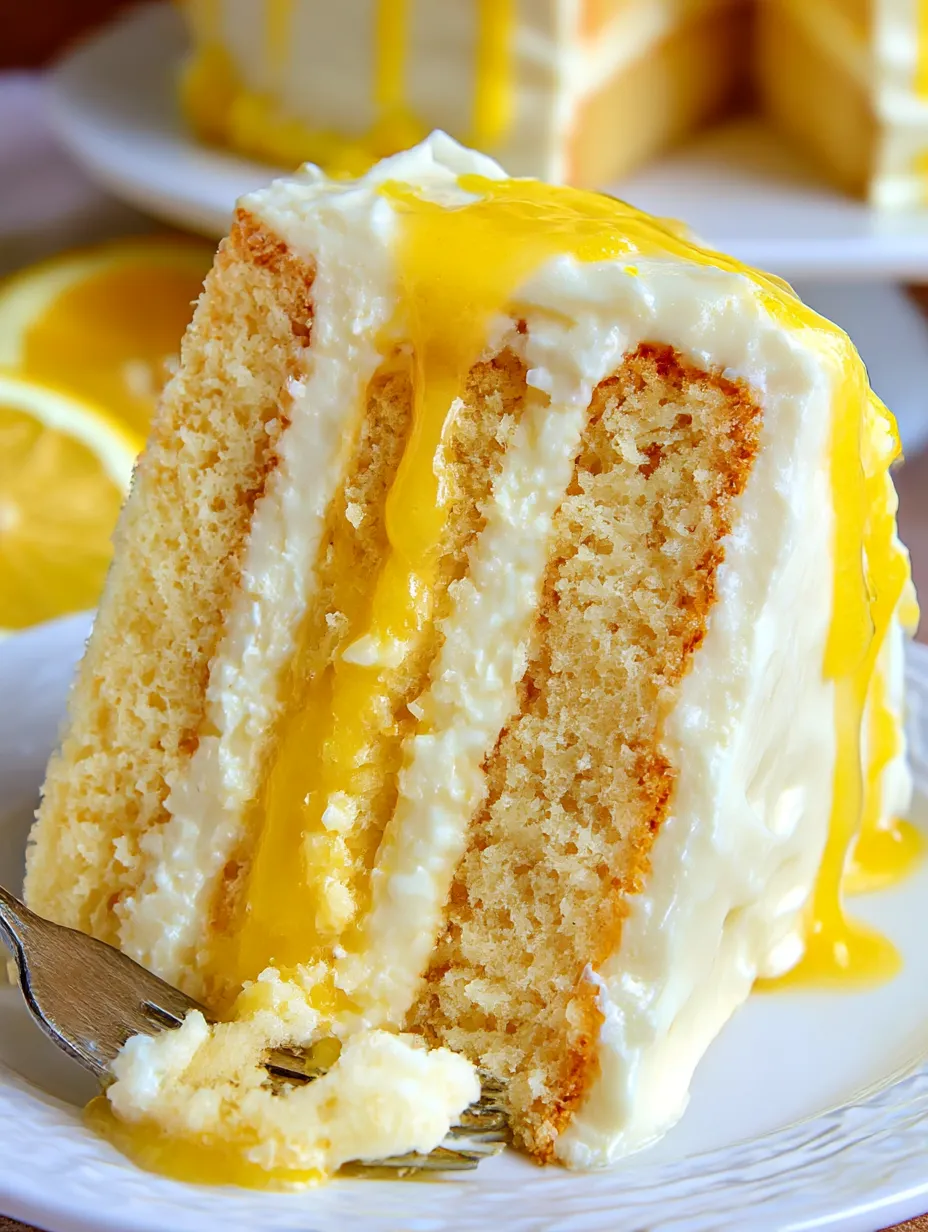 Pin
Pin
This lemon curd cake brings together a tender, fluffy crumb with the bright tang of fresh lemon zest and juice. Each bite is bursting with citrus flavor and layered with rich lemon curd and a dreamy lemon buttercream that keeps friends and family coming back for more. It is my go-to celebration cake when I need to wow both lemon lovers and dessert skeptics alike.
When I first tried this recipe, my kitchen smelled like a lemon grove and my family lined up for slices as soon as the frosting was set. Now my friends request it every brunch or birthday.
Ingredients
- Lemon zest from two lemons: adds intense fragrance and depth to both the crumb and frosting. Select lemons that are heavy for their size with a bright yellow peel.
- Granulated sugar: sweetens and tenderizes the cake. Use a fine white sugar for best results.
- Whole milk: keeps the cake moist and delicate. Room temperature helps everything blend evenly.
- Fresh lemon juice: brings tang and balances sweetness. Strain to remove seeds and any pulp.
- Large egg whites: provide lift for a lighter texture. Room temperature egg whites whip better into the batter.
- Vanilla extract: deepens the flavor and enhances the lemon notes. Choose pure extract for best flavor.
- Bleached cake flour: ensures a fine crumb. Brands like Softasilk work well here for a light and fluffy cake.
- Baking powder: is crucial for rise. Always check freshness for consistent results.
- Table salt: sharpens flavors and balances sweetness. Go for fine salt to blend in seamlessly.
- Unsalted butter: brings rich flavor without overpowering the lemon. Soften but don’t melt for a tender texture.
- Prepared or homemade lemon curd: supplies plenty of zingy filling between layers. Look for one that is thick and glossy with a bright taste if buying ready-made.
- Cream cheese: in the buttercream adds body and a slight tang for balance. Always start with room temperature for smooth frosting.
- Confectioners sugar: sweetens and provides structure to the buttercream. Sift for creamy results.
- Heavy cream: ensures a soft, spreadable frosting that holds up to piped decorations.
Step-by-Step Instructions
- Prepare the Pans:
- Grease three eight-inch cake pans completely and line with parchment circles on the bottom. Grease and flour over the parchment to guarantee easy release after baking.
- Infuse the Sugar:
- Use a food processor to quickly combine lemon zest with a few tablespoons of the sugar until both are combined and the sugar is bright yellow and fragrant. If you do not have a processor, rub the zest into the sugar by hand until the texture feels like damp sand.
- Mix Wet Ingredients:
- In a separate bowl, whisk together the milk, lemon juice, egg whites, and vanilla. Let this sit to bring all liquids up to room temperature for even blending.
- Blend Dry Ingredients with Butter:
- Using a stand mixer, blend cake flour, the rest of the granulated sugar, lemon sugar, baking powder, and salt on low just until mixed. Add butter a small piece at a time and allow it to break down into pea-sized crumbs. This process helps develop a soft, tight crumb.
- Build the Batter:
- Pour in half the wet egg white mix and beat on medium-high until the batter is light, smooth, and fluffy. Reduce the speed and blend in the remaining liquid. Give a few extra stirs by hand to make sure nothing is stuck on the bottom.
- Bake:
- Divide the batter evenly among pans and smooth the tops. Bake at 350 degrees for eighteen to twenty-two minutes. Cakes are done when the tops are light brown and a toothpick comes out clean. Cool layers briefly in the pans, then transfer to a wire rack and let cool completely.
- Make the Lemon Buttercream:
- In an electric or stand mixer, beat the butter and cream cheese until smooth. Gradually add confectioners sugar and salt. Once incorporated, add lemon juice, vanilla, and cream. Beat again until light and fluffy. Use a spatula to fold everything together for a smooth texture.
- Assemble the Cake:
- Place one cooled cake layer on your stand and pipe a thick buttercream border at the edge. Spoon lemon curd into the center. Add the next layer and repeat. Top with final cake layer. Fully frost the sides and top, smoothing or piping extra designs as you like. For a pretty touch, save a bit of curd for flower centers or swirling on top.
 Pin
Pin
One of my favorite parts of making this cake is infusing the sugar with lemon zest because it perfumes the kitchen instantly. My sister always tries to sneak the zest-sugar when I am not looking because she loves the intense smell.
How to Store Lemon Curd Cake
Once assembled, keep this cake covered in the refrigerator to preserve freshness for up to five days. Allow slices to come to room temperature for at least thirty minutes before enjoying so the frosting and cake both become soft again. If you are preparing cake layers ahead of time, wrap them individually in plastic for up to one day on the counter or two days in the refrigerator. Buttercream frosting can also be made ahead and kept chilled for two days.
Ingredient Swaps That Work
If you cannot find bleached cake flour, you can make your own by measuring all-purpose flour, then removing two tablespoons per cup and adding two tablespoons of cornstarch. For dairy-free needs, substitute whole milk and cream with almond or coconut milk, and use a plant-based butter. Lemon curd can be homemade or store bought, but always select one with a vibrant yellow hue and no artificial ingredients.
Serving Ideas
This cake looks stunning presented with fresh edible flowers or curls of lemon zest on top. For a more casual approach, simply dust with confectioners sugar. Serve as a light dessert at spring or summer celebrations or bring to potlucks for guaranteed compliments. If you want to fancy it up, garnish each slice with a tiny, tangy spoonful of extra lemon curd.
The Story Behind the Cake
Lemon cakes are a beloved classic in American home baking, especially in the spring when citrus is at its best. The reverse creaming method used in this recipe is a tip borrowed from professional pastry kitchens to achieve a finer, tighter crumb. By pairing rich buttercream and tangy lemon curd, you get a balanced dessert that appeals to all ages. I learned this style from a friend who grew up near lemon orchards, and every bite transports me straight there.
Recipe FAQs
- → What makes the cake so lemony?
Fresh zest and juice are combined with sugar, lending both intense and subtle citrus notes to each layer.
- → Can I use store-bought curd?
Yes, store-bought lemon curd works well, though homemade offers an extra-bright flavor and creamy texture.
- → What's the best way to frost the cake?
Apply a thin crumb coat, chill, then finish with a smooth layer of buttercream, using a spatula for even coverage.
- → How should I store leftover cake?
Keep leftovers refrigerated in an airtight container; bring to room temperature before serving for optimal texture.
- → Do I need to use cake flour?
Cake flour gives a lighter, more delicate crumb. All-purpose flour can be used but may change the cake's texture slightly.
- → Can I bake the layers in advance?
Yes, cooled cake layers can be wrapped tightly and kept at room temperature for up to one day before assembling.
